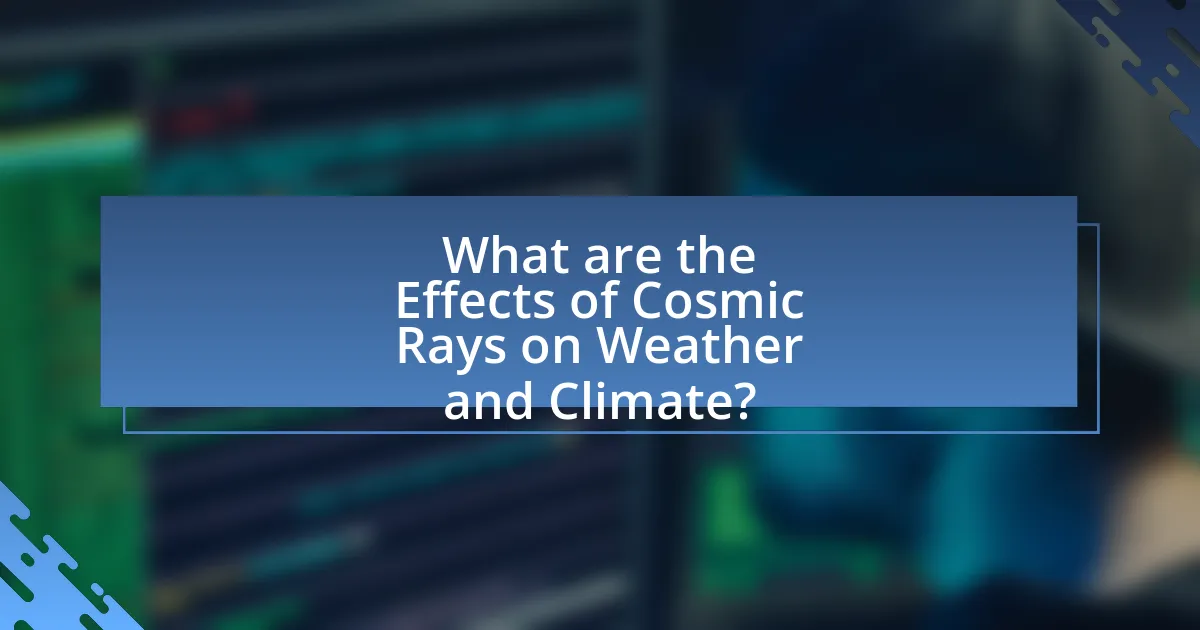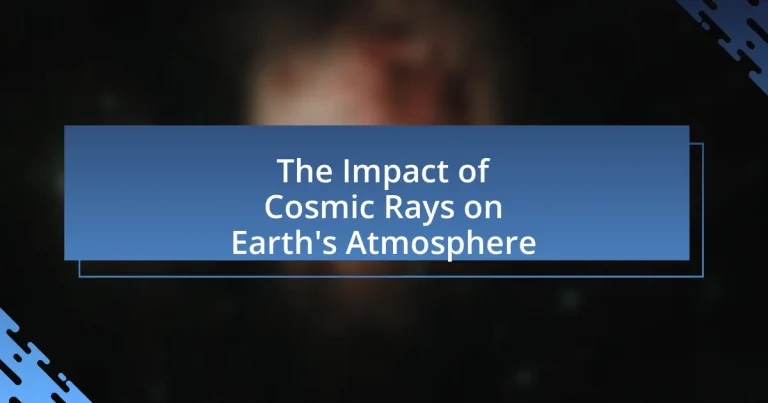Cosmic rays are high-energy particles from outer space that interact with Earth’s atmosphere, leading to the production of secondary particles and influencing atmospheric chemistry. This article explores the origins of cosmic rays, including supernovae and solar activity, and examines their effects on cloud formation, ozone levels, and climate variability. Additionally, it discusses the biological impacts of cosmic rays on living organisms and highlights current research trends and advancements in detection technology aimed at understanding these complex interactions. The implications of cosmic rays for society, particularly in aviation and space exploration, are also addressed, along with strategies for mitigating associated health risks.
What are Cosmic Rays and How Do They Interact with Earth’s Atmosphere?
Cosmic rays are high-energy particles originating from outer space, primarily composed of protons, atomic nuclei, and electrons. When these cosmic rays enter Earth’s atmosphere, they collide with atmospheric molecules, leading to a cascade of secondary particles, including muons, pions, and gamma rays. This interaction occurs at altitudes of about 15 to 30 kilometers, where the density of atmospheric gases is sufficient to facilitate these collisions. Studies have shown that approximately 90% of cosmic rays are protons, and their interactions contribute to various atmospheric phenomena, including the production of isotopes like carbon-14, which is used in radiocarbon dating.
What are the sources of cosmic rays?
Cosmic rays originate primarily from supernova explosions, active galactic nuclei, and the sun. Supernovae are powerful stellar explosions that can accelerate particles to high energies, contributing significantly to cosmic ray flux. Active galactic nuclei, which are supermassive black holes at the centers of galaxies, also emit high-energy particles. Additionally, solar cosmic rays are produced during solar flares and coronal mass ejections, adding to the overall cosmic ray population. These sources have been validated through various astrophysical observations and studies, including data from space-based observatories like the Fermi Gamma-ray Space Telescope, which has identified high-energy emissions from these cosmic phenomena.
How do solar and galactic cosmic rays differ?
Solar cosmic rays originate from the Sun, primarily during solar flares and coronal mass ejections, while galactic cosmic rays come from outside the solar system, originating from supernovae and other high-energy astrophysical processes. Solar cosmic rays are composed mainly of protons and electrons, and their intensity varies with the solar cycle, peaking during solar maximum. In contrast, galactic cosmic rays consist of a broader range of particles, including heavier nuclei, and maintain a relatively constant flux over time. The distinction is significant as solar cosmic rays can affect Earth’s atmosphere and space weather more directly during solar events, while galactic cosmic rays contribute to background radiation levels and have long-term effects on atmospheric chemistry and climate.
What role do supernovae play in cosmic ray production?
Supernovae are significant sources of cosmic ray production, contributing to the acceleration of high-energy particles in the universe. When a star explodes as a supernova, it releases an immense amount of energy, creating shock waves that can accelerate protons and heavier nuclei to relativistic speeds. This process is supported by observations indicating that supernova remnants are sites of cosmic ray acceleration, with studies showing that approximately 10% of the energy from a supernova explosion can be converted into cosmic rays.
How do cosmic rays affect atmospheric chemistry?
Cosmic rays affect atmospheric chemistry primarily by ionizing molecules in the atmosphere, which leads to the formation of secondary particles and reactive species. When cosmic rays collide with atmospheric gases, they produce ionization events that can create free radicals and other reactive intermediates, such as ozone and nitrogen oxides. These newly formed species can influence various chemical reactions, including those involved in cloud formation and the breakdown of greenhouse gases. Studies have shown that cosmic rays can enhance the production of aerosols, which play a crucial role in climate regulation and atmospheric processes. For instance, research indicates that increased cosmic ray activity correlates with variations in cloud cover and climate patterns, demonstrating their significant impact on atmospheric chemistry.
What chemical reactions are initiated by cosmic rays?
Cosmic rays initiate several chemical reactions in the Earth’s atmosphere, primarily through ionization and the production of secondary particles. When cosmic rays, which are high-energy protons and atomic nuclei, collide with atmospheric molecules, they can ionize these molecules, leading to the formation of reactive species such as free radicals and ions. For instance, the interaction of cosmic rays with nitrogen and oxygen in the atmosphere generates nitrogen oxides and ozone, which play significant roles in atmospheric chemistry and climate processes. Studies have shown that these reactions contribute to the formation of aerosols and influence cloud formation, thereby impacting weather patterns and climate.
How do these reactions influence ozone levels?
Cosmic rays influence ozone levels through their interactions with atmospheric gases, leading to the production of nitrogen oxides (NOx) and other reactive species. These reactions can catalyze the breakdown of ozone (O3) in the stratosphere, reducing its concentration. For instance, studies have shown that increased cosmic ray activity correlates with higher levels of NOx, which can deplete ozone by participating in photochemical reactions that convert ozone into oxygen (O2). This relationship highlights the significant role cosmic rays play in modulating ozone levels in Earth’s atmosphere.
What are the biological impacts of cosmic rays on Earth?
Cosmic rays have significant biological impacts on Earth, primarily through their ionizing radiation, which can damage DNA and lead to mutations in living organisms. Research indicates that exposure to cosmic rays can increase the risk of cancer and other genetic disorders due to the alteration of cellular structures. For instance, studies have shown that high-energy particles from cosmic rays can penetrate biological tissues, causing direct damage to DNA strands, which may result in errors during cell replication. Additionally, cosmic rays can influence biological processes such as the production of reactive oxygen species, which can further exacerbate cellular damage.
How do cosmic rays affect living organisms?
Cosmic rays can affect living organisms primarily through the ionization of atoms and molecules in biological tissues, which can lead to cellular damage and mutations. When cosmic rays collide with the Earth’s atmosphere, they produce secondary particles that can penetrate living organisms, potentially causing DNA damage. Studies have shown that exposure to high levels of cosmic radiation can increase the risk of cancer and other health issues in organisms, as evidenced by research conducted on astronauts who experience elevated radiation levels in space. For instance, the National Aeronautics and Space Administration (NASA) has documented that astronauts are at a higher risk for developing cancer due to prolonged exposure to cosmic rays during space missions.
What are the potential health risks associated with cosmic ray exposure?
Cosmic ray exposure poses several potential health risks, primarily including increased cancer risk, acute radiation syndrome, and potential damage to the central nervous system. Research indicates that cosmic rays, which are high-energy particles from outer space, can penetrate human tissue and cause ionization, leading to cellular damage. For instance, studies have shown that astronauts exposed to cosmic radiation during space missions have a higher likelihood of developing cancer due to the cumulative effects of radiation exposure over time. Additionally, acute radiation syndrome can occur with high doses of radiation, leading to symptoms such as nausea, vomiting, and fatigue. Furthermore, there is evidence suggesting that cosmic rays may adversely affect cognitive functions and increase the risk of neurodegenerative diseases.

What are the Effects of Cosmic Rays on Weather and Climate?
Cosmic rays can influence weather and climate by affecting cloud formation and atmospheric processes. Research indicates that cosmic rays contribute to the ionization of the atmosphere, which can enhance the nucleation of cloud droplets. A study published in the journal “Atmospheric Chemistry and Physics” by Svensmark and Friis-Christensen in 1997 suggested that increased cosmic ray activity correlates with higher cloud cover, potentially leading to cooling effects on the Earth’s surface. Additionally, variations in cosmic ray intensity, influenced by solar activity, may impact climate patterns over extended periods, as evidenced by historical climate data showing correlations between cosmic ray flux and temperature changes.
How do cosmic rays influence cloud formation?
Cosmic rays influence cloud formation by ionizing particles in the atmosphere, which can lead to the nucleation of cloud droplets. When cosmic rays collide with atmospheric molecules, they create secondary particles and ions that serve as condensation nuclei, facilitating the process of cloud formation. Research conducted by the University of California, Irvine, published in the journal “Geophysical Research Letters,” indicates that increased cosmic ray activity correlates with enhanced cloud cover, suggesting a direct link between cosmic rays and cloud dynamics.
What is the connection between cosmic rays and cloud condensation nuclei?
Cosmic rays influence cloud condensation nuclei (CCN) by ionizing particles in the atmosphere, which enhances the formation of CCN. This ionization process leads to the creation of aerosols that serve as nuclei for cloud droplets. Research indicates that increased cosmic ray activity correlates with higher cloud cover, as demonstrated in studies like the one by Svensmark et al. (2007), which found a link between cosmic ray intensity and cloud formation patterns. This connection suggests that cosmic rays play a significant role in modulating Earth’s climate through their effect on cloud properties.
How might cosmic rays affect precipitation patterns?
Cosmic rays may influence precipitation patterns by affecting cloud formation and atmospheric processes. Research indicates that cosmic rays can ionize particles in the atmosphere, which may enhance the nucleation of cloud droplets. A study published in the journal “Atmospheric Chemistry and Physics” by Svensmark et al. (2016) found that increased cosmic ray activity correlates with higher cloud cover, which can lead to changes in precipitation. This suggests that variations in cosmic ray intensity could potentially alter regional and global precipitation patterns over time.
What is the relationship between cosmic rays and climate change?
Cosmic rays have a complex relationship with climate change, primarily influencing cloud formation and atmospheric processes. Research indicates that cosmic rays can ionize particles in the atmosphere, which may enhance cloud condensation nuclei, potentially leading to increased cloud cover and changes in climate patterns. A study published in the journal “Environmental Research Letters” by Svensmark and Calder (2007) suggests that variations in cosmic ray intensity correlate with historical climate changes, indicating a possible link between cosmic rays and Earth’s climate system. However, the overall impact of cosmic rays on climate change remains a subject of ongoing research and debate within the scientific community.
How do cosmic rays contribute to climate variability?
Cosmic rays contribute to climate variability primarily by influencing cloud formation and atmospheric processes. When cosmic rays enter the Earth’s atmosphere, they can ionize air molecules, which may lead to the formation of aerosols that serve as cloud condensation nuclei. This process can enhance cloud cover and alter the Earth’s albedo, thereby affecting climate patterns. Research by Svensmark and colleagues has shown that variations in cosmic ray intensity correlate with changes in cloud cover, suggesting a link between cosmic rays and climate variability. Specifically, during periods of increased solar activity, cosmic ray flux decreases, which may lead to reduced cloud formation and warmer temperatures, as observed in historical climate data.
What evidence supports the link between cosmic rays and climate fluctuations?
Evidence supporting the link between cosmic rays and climate fluctuations includes studies showing that increased cosmic ray activity correlates with cloud formation and changes in Earth’s climate. Research by Svensmark et al. indicates that cosmic rays can influence the formation of aerosols, which in turn affect cloud cover and climate patterns. Additionally, historical climate data reveals periods of increased cosmic ray intensity coinciding with cooler climate phases, suggesting a potential mechanism where cosmic rays impact climate through modulation of cloud properties.
What are the Current Research Trends on Cosmic Rays and Earth’s Atmosphere?
Current research trends on cosmic rays and Earth’s atmosphere focus on understanding the interactions between high-energy cosmic rays and atmospheric processes. Studies are investigating how cosmic rays influence cloud formation and climate patterns, with evidence suggesting that increased cosmic ray activity correlates with changes in cloud cover and precipitation. For instance, research published in the journal “Atmospheric Chemistry and Physics” by authors such as J. M. McCaffrey et al. (2021) highlights the potential role of cosmic rays in modulating the Earth’s climate through ionization processes in the atmosphere. Additionally, advancements in detection technology are enabling more precise measurements of cosmic ray flux and its effects on atmospheric chemistry, further enhancing our understanding of these complex interactions.
What advancements have been made in cosmic ray detection technology?
Recent advancements in cosmic ray detection technology include the development of more sensitive and precise detectors, such as the Large High Altitude Air Shower Observatory (LHAASO) in China, which can detect cosmic rays with energies exceeding 1 PeV. These detectors utilize advanced photomultiplier tubes and digital readout systems to enhance signal detection and data collection. Additionally, the use of machine learning algorithms has improved the analysis of cosmic ray data, allowing for better identification of cosmic ray sources and their interactions with the Earth’s atmosphere. These advancements have significantly increased the understanding of cosmic ray behavior and their impact on atmospheric processes.
How do modern instruments improve our understanding of cosmic rays?
Modern instruments enhance our understanding of cosmic rays by providing precise measurements of their energy, composition, and arrival directions. Advanced detectors, such as the Large High Altitude Air Shower Observatory (LHAASO) and the Alpha Magnetic Spectrometer (AMS-02), utilize cutting-edge technology to capture and analyze cosmic ray interactions with the Earth’s atmosphere. These instruments can detect high-energy particles and measure their properties with unprecedented accuracy, allowing researchers to identify the sources of cosmic rays and their potential effects on atmospheric chemistry and climate. For instance, LHAASO has reported the detection of gamma rays from cosmic ray interactions, contributing to the understanding of high-energy astrophysical processes.
What are the challenges in measuring cosmic rays accurately?
Measuring cosmic rays accurately presents several challenges, primarily due to their high energy, variability, and interaction with the Earth’s atmosphere. Cosmic rays are charged particles that can be influenced by magnetic fields, making their trajectories difficult to track. Additionally, the Earth’s atmosphere absorbs and scatters these particles, complicating direct measurements. For instance, ground-based detectors often rely on secondary particles produced when cosmic rays collide with atmospheric molecules, which can lead to uncertainties in the original cosmic ray’s energy and composition. Furthermore, the sporadic nature of cosmic ray events, influenced by solar activity and other cosmic phenomena, adds variability that complicates consistent measurement. These factors collectively hinder the precision of cosmic ray measurements, as highlighted by studies such as those conducted by the Pierre Auger Collaboration, which emphasize the need for advanced detection techniques to improve accuracy.
What future studies are planned to explore cosmic rays’ effects?
Future studies planned to explore cosmic rays’ effects include the use of advanced satellite missions and ground-based observatories to measure cosmic ray interactions with the Earth’s atmosphere. For instance, the upcoming NASA mission, the Atmospheric Imaging Assembly, aims to analyze how cosmic rays influence atmospheric chemistry and cloud formation. Additionally, collaborations between institutions like CERN and various universities are focusing on particle physics experiments to understand cosmic ray origins and their impact on climate patterns. These studies are essential for developing accurate models of atmospheric processes influenced by cosmic rays, as evidenced by previous research indicating a correlation between cosmic ray activity and climate variability.
What hypotheses are researchers testing regarding cosmic rays and atmospheric phenomena?
Researchers are testing hypotheses that cosmic rays influence atmospheric phenomena, particularly cloud formation and climate patterns. One hypothesis suggests that increased cosmic ray activity correlates with higher cloud cover, potentially affecting Earth’s climate by altering solar radiation absorption. Studies, such as those by Svensmark, indicate that cosmic rays may ionize particles in the atmosphere, leading to cloud condensation nuclei formation, which can enhance cloudiness. Additionally, researchers are investigating the potential link between cosmic rays and lightning frequency, proposing that cosmic rays may trigger electrical discharges in the atmosphere. These hypotheses are grounded in observational data and experimental findings that explore the interactions between cosmic rays and atmospheric processes.
How might future findings impact our understanding of Earth’s climate system?
Future findings regarding cosmic rays may significantly enhance our understanding of Earth’s climate system by revealing their role in cloud formation and atmospheric processes. Research indicates that cosmic rays can influence the ionization of the atmosphere, which in turn affects cloud condensation nuclei and cloud properties. For instance, a study published in the journal “Atmospheric Chemistry and Physics” by Svensmark et al. (2016) demonstrated that increased cosmic ray activity correlates with changes in cloud cover, potentially impacting global temperatures. Such insights could lead to more accurate climate models and predictions, ultimately refining our comprehension of climate dynamics and variability.
What practical implications do cosmic rays have for society?
Cosmic rays have significant practical implications for society, particularly in the fields of aviation, space exploration, and health. These high-energy particles can disrupt electronic systems in aircraft, leading to potential malfunctions and increased radiation exposure for passengers and crew. For instance, studies have shown that cosmic radiation levels increase at high altitudes, necessitating flight path adjustments and monitoring for long-haul flights to minimize exposure. In space exploration, cosmic rays pose a risk to astronauts, requiring protective measures in spacecraft design to mitigate health risks such as cancer and acute radiation syndrome. Additionally, cosmic rays contribute to atmospheric processes, influencing climate patterns and weather systems, which can have broader implications for agriculture and disaster preparedness.
How can we mitigate the risks associated with cosmic ray exposure?
To mitigate the risks associated with cosmic ray exposure, implementing shielding strategies is essential. Shielding can be achieved through the use of materials such as lead or polyethylene, which effectively absorb or deflect cosmic radiation. Research indicates that spacecraft and habitats designed for long-duration space missions, like those proposed for Mars, utilize these materials to reduce radiation exposure by up to 90%. Additionally, monitoring cosmic radiation levels with real-time detection systems allows for timely protective measures, such as relocating to shielded areas during high-radiation events. These strategies are supported by data from NASA’s studies on radiation exposure in space environments, which emphasize the importance of proactive measures in safeguarding human health against cosmic rays.
What strategies can be employed to enhance public awareness of cosmic rays?
To enhance public awareness of cosmic rays, educational outreach programs can be implemented in schools and community centers. These programs can include interactive workshops, lectures by scientists, and hands-on experiments that demonstrate the effects of cosmic rays on Earth’s atmosphere. For instance, the Cosmic Ray Observatory projects have successfully engaged students by allowing them to participate in data collection and analysis, fostering a deeper understanding of cosmic rays and their significance. Additionally, utilizing social media campaigns and public science events can effectively disseminate information about cosmic rays to a broader audience, as evidenced by the success of initiatives like the International Cosmic Ray Conference, which attracts public interest and media coverage.


